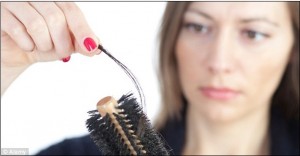When thinning and loss of volume occur — whether temporary or permanent — you may experience diminished self-confidence, negative self-esteem and a myriad of other emotional issues. However, in order to treat your hair loss and/or bald spots, you must first understand the underlying cause or causes.

CAUSES FOR HAIR LOSS IN WOMEN
Different factors contribute to a woman’s hair loss rather than a man’s hair loss. Appearances differences also vary between the sexes. Women typically experience hair loss temporarily due to psychological factors and permanently due to hormonal imbalance and aging. Men, on the other hand, usually lose their hair based mainly on genetics.
However, pattern baldness is the most common factor in hair loss for women and men. Pattern baldness is medically known as androgenic alopecia, which is a permanent, genetic-based condition. It also affects hair loss in women and men differently. Pattern baldness results from an abundance of the hormone dihydrotestosterone, or DHT. Though it’s present in all human scalps, DHT miniaturizes hair follicles and eventually leads to hair less. Women and men with genetically weak androgen receptors suffer hair loss.
Unfortunately, 40 percent of women have visible hair loss by the time they are 40-years-old, according to the American Academy of Dermatology. The American Health Journal reports that 21 million women in the U.S. experience a form of hair loss, whether it’s extensive hair loss or thinning. Though pattern baldness does not cause a receding hairline in women and rarely leads to baldness, hair thins over the entire head. Women deal with the issue by adding extensions but hair transplants in women are increasing due to the efficacy of the surgery and more awareness for permanent, minimally invasively hair restoration options.
HAIR TRANSPLANTS FOR WOMEN ARE INCREASING IN LONDON DUE TO MORE AWARENESS
While men were traditionally the main patients for hair transplants, hair transplants in women are increasing by 82 percent in one London clinic, The Public Clinic. Women typically used temporary hair extensions as a solution to hair loss or thinning or suffered with the condition in silence. However, more women are now aware of the permanent solutions available with hair transplants and follicular unit extraction (FUE).
FUE involves extracting individual follicular units one at a time with the harvesting using 0.8 to 1.2 millimeter punches for extraction. The grafts are then individually transplanted to the recipient area where this is thinning and/or balding.
The Public Clinic reveals hair transplants for women are increasing:
- 82 percent increase for women in the first eight months of this year, compared with the same period in 2011
- 39 is the average age of women opting for a hair transplant
- Hair transplant surgeons contribute the increase to more awareness of options
- High-profile celebrities undergoing hair transplant procedures are also crediting with the increase in all hair transplants
- Male hair transplants are also increasing
If you are currently suffering from hair loss and female pattern baldness, schedule an appointment with your hair transplant surgeon. Hair transplants for women are increasing due to more awareness and the FUE technique being a less invasive surgery than those of the past. Additionally, hair transplants for women are increasing since women are finding that it’s a permanent solution to a sometimes devastating condition.
